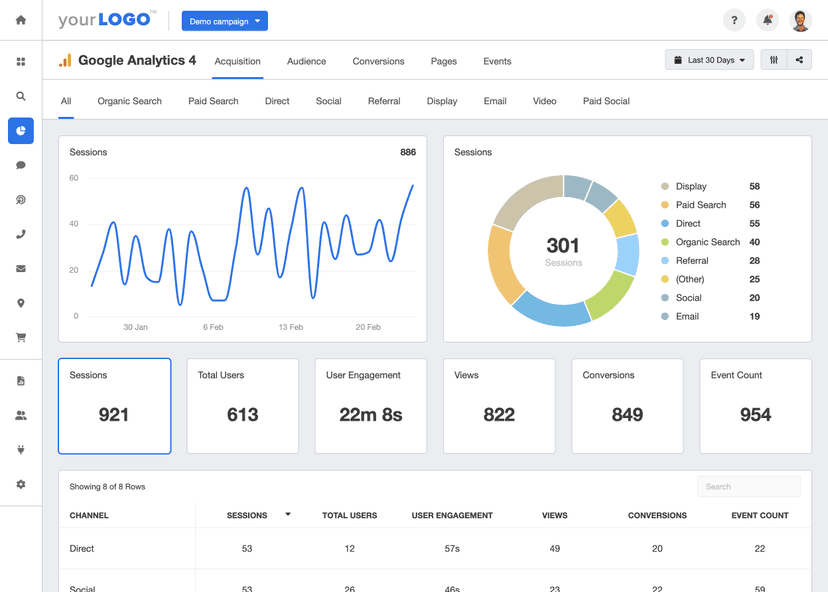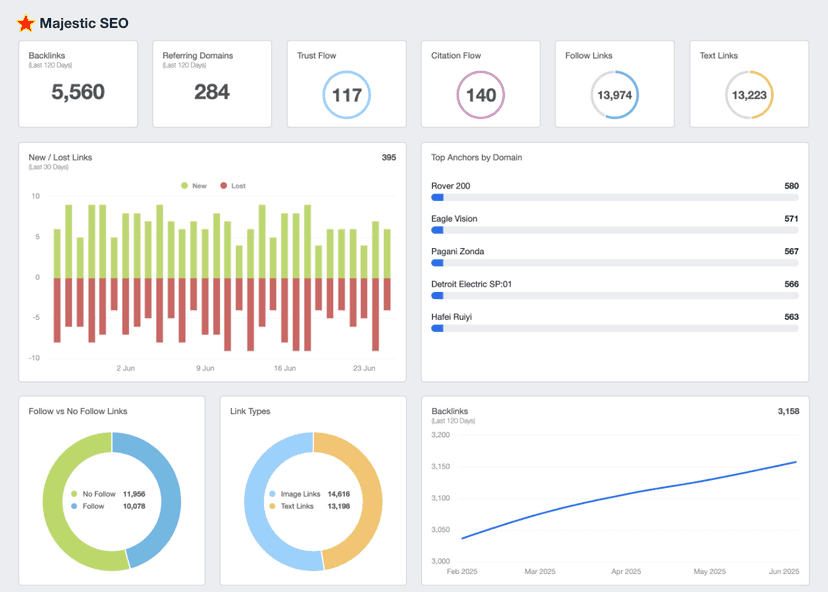Keyword Volume
Trend Analysis
Identifies popular topics, guiding timely strategy shifts.
Content Focus
Targets high-volume keywords for engaging content creation.
Ad Strategy
Directs PPC campaigns towards profitable keywords.
SEO Boost
Optimizes web content for better search engine visibility.
Why Keyword Volume Is Important
Keyword Volume offers deep insights into consumer behavior and market trends. Tracking this metric helps marketers understand what audiences are searching for, which directly impacts content and strategy development. A higher volume indicates greater interest, making it essential for prioritizing keywords in SEO and content creation.
Keyword Volume plays a crucial role in campaign planning and forecasting. By analyzing search volumes, marketers predict demand, tailor content plans, and allocate resources more effectively. This metric guides immediate strategy adjustments and also aids in long-term planning. Researching Keyword Volume ensures marketing efforts are aligned with audience interests and market dynamics. It’s a window into the public's current interests, making it an indispensable tool for informed decision-making for clients and agencies alike.
Stop Wasting Time on Manual Reports... Get SEO Insights Faster With AgencyAnalytics
How Keyword Volume Relates To Other KPIs
Keyword Volume is a two-way street. High-volume keywords, for example, often correlate with increased website traffic. As more users search for these terms, the potential for higher traffic grows, making it a valuable metric for gauging potential audience reach.
Conversion Rates also share a relationship with Keyword Volume. While high volume typically drives more traffic, the quality of that traffic matters. A keyword with a lower volume but a higher Conversion Rate tends to be more valuable, showing the importance of balancing volume with conversion potential.
It is also important to note that higher Keyword Volume typically comes hand-in-hand with a higher Keyword Difficulty score. The more attractive a keyword is to marketers based on the Keyword Volume, the more competitive the keyword will become. Popular keywords are typically more competitive, requiring more nuanced SEO strategies to rank well.
Key Factors That Impact Keyword Volume
Several factors have the potential to significantly influence Keyword Volume. Seasonal trends are a primary influencer, as certain keywords spike during specific times of the year, like holidays or seasonal events. Marketers need to anticipate these fluctuations with keyword research, helping to capitalize on the increased search interest. This also helps inform keyword ideas to use for a client’s upcoming campaign.
Another critical factor is current events and pop culture. News, viral topics, and trending conversations suddenly elevate the search volume of relevant keywords. Staying attuned to these shifts enables marketers to adapt their strategies in real time, leveraging the surge in the public interest.
Keep in mind that as consumer behavior changes, technological advancements or societal trends also impact Keyword Volume. Understanding and predicting these trends is essential for maintaining relevance and engagement in any industry.
It’s all in the data. In order to effectively and efficiently launch a new Google Ads campaign, we start by analyzing the market and the competition to determine potential costs and the level of competitiveness. This includes things like industry standard budgets, CPC and CTR, current advertisers, and keyword search trends and volume.
How To Estimate Keyword Volume
Estimating Keyword Volume effectively requires using some of the best keyword research tools, such as the Google Keyword Planner, Ahrefs, or Semrush. Agencies often use a free keyword tool to get estimations of an average monthly search volume.
By entering specific keywords into a free keyword research tool, marketers access data that showcases the keyword's popularity and trends. The process involves analyzing this data to understand the potential reach and impact of specific keywords in marketing campaigns. For example, using a free keyword generator to highlight new terms to place in content to help it rank higher in the SERPs.
What Is a Good Average Keyword Volume?
A "good" average Keyword Volume often depends on specific industry and campaign goals. High search volumes, typically in the thousands per month, indicate strong interest and potential for broad reach, especially for general or popular topics. However, for niche markets or specialized topics, a few hundred monthly searches might be significant, offering targeted engagement with less competition.
What Is a Bad Average Keyword Volume?
A "bad" average Keyword Volume usually signifies very low search interest, often in the tens or lower per month. This low level suggests limited audience engagement potential, which might not justify the investment in targeting such keywords. However, it's crucial to consider context: Some highly specific or niche keywords, despite low volume, are valuable for targeted or specialized campaigns.
How To Set Keyword Volume Benchmarks and Goals
Agencies often set their own Keyword Volume benchmarks based on factors like industry standards and campaign goals.
Agencies also back-calculate the required Keyword Volume to meet specific revenue targets, considering Click-Through Rates, Conversion Rates, and Average Order Values. For example, if the client wants to drive an additional 100,000 in revenue through organic search, based on a conversion rate of 10% and an AOV of $100, an agency forecasts that it needs to drive 10,000 additional organic clicks. To do so, they'd need to achieve an average ranking of #7 with a CTR of 3.9%, for a collection of keywords with a total volume of 256,000.
Why Keyword Volume Matters to Clients
From a client's perspective, Keyword Volume helps to understand market relevance and customer interest. It's a tangible measure of how often potential customers are searching for topics related to their products or services.
High Keyword Volume indicates a large audience pool, suggesting greater potential for website traffic and brand exposure. Clients view this metric as a direct line to understanding consumer trends and demand, enabling them to align their offerings more closely with what their audience is actively seeking.
Combined with Keyword Difficulty, Keyword Volume also helps clients gauge the competitiveness of their market. Understanding the search popularity of certain terms influences marketing strategies, like content development and product positioning, ensuring they remain relevant and visible in a crowded online market. Showcase your client's keyword ranking report with our template.
Why Keyword Volume Matters to Agencies
For marketing agencies, Keyword Volume provides a predictive metric that helps inform the level of effort and resources that should be invested in targeting specific keywords. High-volume keywords, while attractive due to their potential reach, often come with stiff competition. This insight helps agencies to develop sophisticated SEO strategies and content plans to compete effectively.
Further, agencies use Keyword Volume combined with Keyword Difficulty to build content and SEO strategies that target the best keywords to drive significant traffic to their clients' sites. This metric also assists in predictive analysis, helping agencies forecast trends and adapt strategies proactively, ensuring they stay ahead in their competitive market.
Save Time and Money by Automating Your Client Reporting
Best Practices When Analyzing and Reporting on Keyword Volume
When analyzing Keyword Volume, agencies aim to estimate the potential search traffic their client will receive. Here are six best practices to keep in mind.
Ensure Data Accuracy
Utilize reliable SEO tools and cross-verify data sources to ensure that the keyword search volume data reflects true market search behaviors.
Analyze Keyword Volume Over Time
Track Keyword Volume over extended periods to spot trends, seasonal variations, and growth patterns and understand the keyword's lifecycle and its potential future impact on campaigns.
Visualize Keyword Volume Impact
Create visual representations of Keyword Volume data to convey performance insights more effectively and communicate any improvements to website traffic.
Put Keyword Volume in Context
Consider market competition, audience intent, and relevancy to ensure the keyword aligns with the broader marketing strategy and objectives.
Align Keyword Volume to Client Goals
Match Keyword Volume insights to client-specific goals, ensuring that keyword strategies directly contribute to client objectives, from increasing brand awareness to driving sales.
Include Actionable Recommendations
Suggest specific keywords to target, content creation ideas, or SEO adjustments to optimize campaign performance based on Keyword Volume insights.
FAQs About Keyword Volume and Keyword Research
Keyword search volumes are one of the most important metrics for SEO and PPC keyword research. These FAQs explain how agencies evaluate keyword volume, find suitable keywords, and track performance for smarter SEO strategies and campaigns.
Keyword Volume is the estimated number of times a specific keyword is searched in a given timeframe. It’s typically measured monthly and calculated by automated tools that analyze search engine data.
Understanding Keyword Volume is critical for SEO because it highlights what a target audience is actively searching for. It helps prioritize high-impact keywords that improve visibility, guide campaign planning, and increase organic traffic.
A good keyword search volume depends on the client’s goals, competition, and industry. High search volume keywords can drive more traffic but often come with higher competition and CPCs. Low competition keywords with moderate monthly search volumes may deliver better ROI for SEO efforts and PPC keyword research, especially when they align with the target keyword and client objectives.
Keyword Volume directly influences content creation by identifying topics with high interest. Targeting these keywords ensures content aligns with search demand, improving ranking potential and driving meaningful website traffic.
Tools like Google Keyword Planner, Ahrefs, Semrush, and other free keyword generators provide accurate Keyword Volume data. These platforms help agencies analyze trends, identify new opportunities, and validate SEO strategies.
High Keyword Volume often means increased competition. To get results faster, agencies should mix in lower-difficulty keywords while still targeting broader terms. This approach builds momentum and supports long-term SEO growth.
It depends on the campaign goal. High search volume keywords may increase visibility but often come with more competition. Low competition keywords with mid-range monthly search volumes are often more effective for generating new keywords, capturing potential traffic, and driving more conversions with suitable keywords that align to the target audience.
All three are critical metrics, but intent usually matters most for client SEO strategy. A given keyword may have high search volume, but if the search queries don’t match the client’s landing page or offering, it won’t drive conversions. Keyword difficulty provides insight into competition, while keyword volume shows monthly search volumes. Agencies balance all three factors to choose the right keywords.
PPC keyword volume comes from Google Ads accounts and reflects paid keywords with impression data based on ad campaigns. SEO keyword volume comes from organic keyword research tools and reflects how often people search for a given keyword across search engines. Both are valuable advertising metrics but serve different purposes in campaign planning.
PPC keyword research focuses on finding keywords that maximize cost efficiency and conversions in ad campaigns, often using Google Ads Keyword Planner for precise data. SEO keyword research looks at organic keyword search volumes, search volume ranges, and keyword analysis to guide long-term SEO efforts. Together, PPC and organic keyword research provide agencies with a more comprehensive keyword strategy.
Agencies use a position tracking tool like the AgencyAnalytics Keyword Rank Tracker to monitor performance. The dashboard shows keyword ranking over time, new keywords gained, and position tracking for both Google and other search engines. Tracking these important metrics ensures agencies can measure SEO strategy impact and refine keyword lists to keep finding keywords that drive results.
Semrush Dashboard Example

Related Integrations
How To Use Keyword Volume To Drive Growth
Leveraging Keyword Volume effectively significantly fuels a client’s growth strategy. By utilizing the power of popular search terms, agencies increase website visibility, drive traffic, and ultimately, spur growth for a brand or business.
Target Long-Tail
Long-tail keywords are less competitive but highly specific, often leading to better conversion rates. By targeting long-tail keywords, agencies attract a more targeted audience, gradually increasing the volume for broader, related keywords.
On-Page SEO
Optimize on-page elements. Ensure that titles, meta descriptions, and headers include the target keywords. Well-optimized pages rank better on search engines, making the keywords more visible and likely to be searched.
Analyze Competitors
Study competitor keyword strategies. Identify the keywords that are working well for competitors in the particular niche. Implementing similar strategies helps tap into an existing audience looking for similar content or services.
Related Blog Posts
See how 7,000+ marketing agencies help clients win
Free 14-day trial. No credit card required.
















